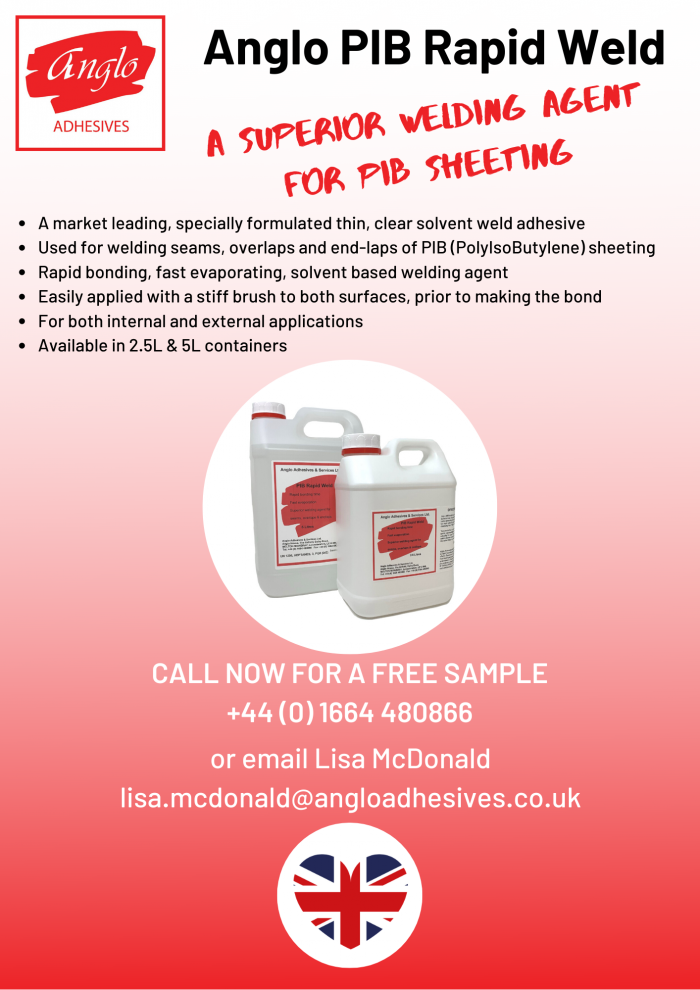Blog
Anglo PIB Rapid Weld Bonding – A Superior Welding Agent For PIB Sheeting
Anglo PIB Rapid Weld is a rapid weld bonding, fast evaporating solvent based welding agent for the effective lagging of pipework.
Developed for the insulation, building and construction industries, Anglo PIB Rapid Weld is used extensively for bonding PIB as well as joining PIB Sheeting to protect insulated products when lagging pipework. The ease of use has made this product a market leader for many years. Weld bonding is a hybrid joining process that combines the principles of adhesive bonding and welding.
Available in easy to handle 2.5L and 5L containers.
Below we have a brief overview of the product and its benefits.

What is weld bonding?
Weld bonding is a joining process that combines traditional welding and adhesive bonding techniques. In this method, adhesive materials are applied between two or more metal components, and then a welding process is used to create a strong mechanical bond. The adhesive acts as both a bonding agent and a sealant, enhancing the overall integrity and performance of the joint. Weld bonding represents a fusion of adhesive bonding and welding techniques.
What are the benefits of weld bonding?
- Enhanced Strength: Weld bonding combines the mechanical strength of welding with the adhesive’s bonding capabilities, resulting in a joint that is stronger than traditional welding alone.
- Improved Fatigue Resistance: The adhesive layer helps distribute stress and reduces the risk of fatigue failure in the joint.
- Corrosion Resistance: Adhesive materials can act as a barrier against corrosion, protecting the joint and extending its lifespan.
- Reduced Heat-Affected Zone (HAZ): Unlike conventional welding, weld bonding generates less heat during the process, minimising the size of the heat-affected zone and reducing distortion in the workpiece.
- Versatility: Weld bonding can be used with a wide range of materials and is particularly effective for dissimilar material combinations.
- Vibration Damping: The adhesive layer can absorb vibrations and dampen noise, making it suitable for applications where noise reduction is essential.
- Aesthetics: Weld bonding can provide a smoother, cleaner joint appearance compared to traditional welds, making it suitable for applications where aesthetics are important.
What are the disadvantages of weld bonding?
- Process Complexity: Weld bonding involves multiple steps, including surface preparation, adhesive application, and welding, which can increase production time and complexity.
- Material Compatibility: Not all materials are suitable for weld bonding, and compatibility between the adhesive and the base materials must be carefully considered.
- Cost: The additional adhesive materials and labor involved in weld bonding can make it more expensive than conventional welding methods.
- Quality Control: Ensuring proper adhesive application and weld quality requires strict quality control measures, which can be time-consuming and costly.
- Environmental Considerations: Some adhesive materials may have environmental concerns, and their disposal or recycling can pose challenges.
What is the difference between welding and adhesive bonding?
Welding and adhesive bonding are two distinct joining processes with key differences:
- Mechanism: Welding relies on melting and fusing the base materials to create a joint, while adhesive bonding uses adhesive materials to bond the components together without melting.
- Strength: Welding typically results in a stronger mechanical joint due to the fusion of materials, whereas adhesive bonding relies on the adhesive’s strength.
- Heat Generation: Welding generates significant heat, which can affect the properties of the base materials and create a heat-affected zone (HAZ). Adhesive bonding generates minimal heat.
- Material Compatibility: Welding is often limited to similar materials, while adhesive bonding can join dissimilar materials effectively.
- Appearance: Adhesive bonding can provide a cleaner, smoother joint appearance, whereas welding may leave visible weld seams.
- Fatigue Resistance: Adhesive bonding can improve fatigue resistance by distributing stress, while welds may be more susceptible to fatigue failure.
- Corrosion Protection: Adhesive bonding can offer better corrosion protection due to the sealing properties of the adhesive.
To request a free sample or to place an order
Call +44 (0) 1664 480866
or email Lisa McDonald at lisa.mcdonald@angloadhesives.co.uk
For technical advice
Call Terry Lake on +44 (0) 1664 480866
or email terry.lake@angloadhesives.co.uk
You can also fill out our contact form by clicking here.
Stay up to date with our latest product news on LinkedIn, Instagram & Facebook.